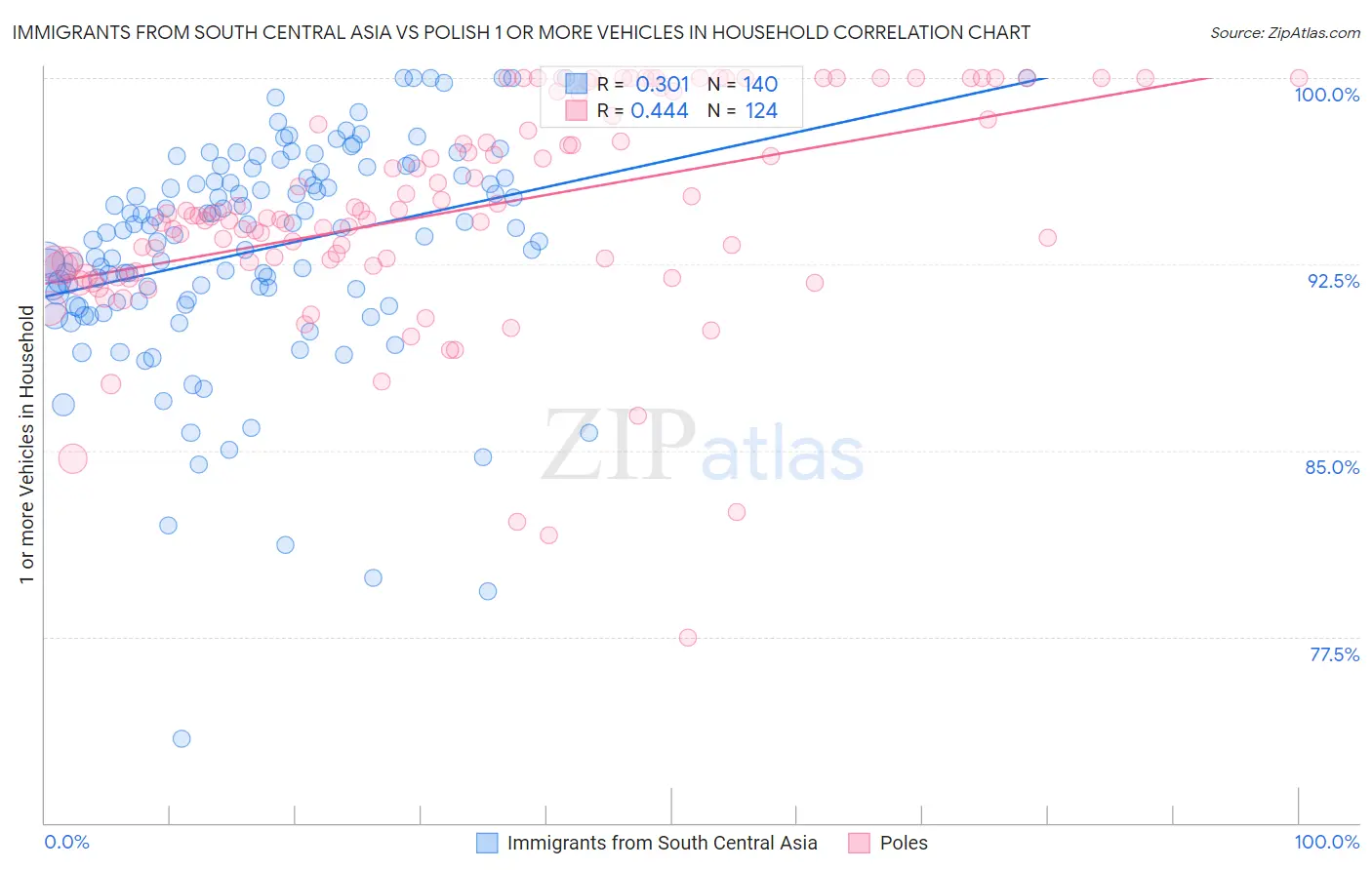Immigrants from South Central Asia vs Polish 1 or more Vehicles in Household
COMPARE
Immigrants from South Central Asia
Polish
1 or more Vehicles in Household
1 or more Vehicles in Household Comparison
Immigrants from South Central Asia
Poles
91.5%
1 OR MORE VEHICLES IN HOUSEHOLD
99.4/ 100
METRIC RATING
79th/ 347
METRIC RANK
91.7%
1 OR MORE VEHICLES IN HOUSEHOLD
99.7/ 100
METRIC RATING
71st/ 347
METRIC RANK
Immigrants from South Central Asia vs Polish 1 or more Vehicles in Household Correlation Chart
The statistical analysis conducted on geographies consisting of 459,427,111 people shows a mild positive correlation between the proportion of Immigrants from South Central Asia and percentage of households with 1 or more vehicles available in the United States with a correlation coefficient (R) of 0.301 and weighted average of 91.5%. Similarly, the statistical analysis conducted on geographies consisting of 560,073,045 people shows a moderate positive correlation between the proportion of Poles and percentage of households with 1 or more vehicles available in the United States with a correlation coefficient (R) of 0.444 and weighted average of 91.7%, a difference of 0.22%.

1 or more Vehicles in Household Correlation Summary
| Measurement | Immigrants from South Central Asia | Polish |
| Minimum | 73.4% | 77.5% |
| Maximum | 100.0% | 100.0% |
| Range | 26.6% | 22.5% |
| Mean | 93.1% | 94.7% |
| Median | 93.8% | 94.4% |
| Interquartile 25% (IQ1) | 91.0% | 92.5% |
| Interquartile 75% (IQ3) | 96.0% | 98.4% |
| Interquartile Range (IQR) | 5.0% | 5.9% |
| Standard Deviation (Sample) | 4.5% | 4.4% |
| Standard Deviation (Population) | 4.4% | 4.4% |
Demographics Similar to Immigrants from South Central Asia and Poles by 1 or more Vehicles in Household
In terms of 1 or more vehicles in household, the demographic groups most similar to Immigrants from South Central Asia are Bolivian (91.5%, a difference of 0.0%), Immigrants from Philippines (91.5%, a difference of 0.020%), Iranian (91.5%, a difference of 0.020%), Immigrants from South Eastern Asia (91.4%, a difference of 0.040%), and Lebanese (91.4%, a difference of 0.040%). Similarly, the demographic groups most similar to Poles are Cajun (91.7%, a difference of 0.0%), Immigrants from Iran (91.7%, a difference of 0.010%), Lithuanian (91.7%, a difference of 0.020%), Palestinian (91.7%, a difference of 0.040%), and Immigrants from Lebanon (91.6%, a difference of 0.050%).
| Demographics | Rating | Rank | 1 or more Vehicles in Household |
| Immigrants | Laos | 99.8 /100 | #65 | Exceptional 91.8% |
| Canadians | 99.8 /100 | #66 | Exceptional 91.8% |
| Spaniards | 99.8 /100 | #67 | Exceptional 91.8% |
| Immigrants | Scotland | 99.7 /100 | #68 | Exceptional 91.8% |
| Palestinians | 99.7 /100 | #69 | Exceptional 91.7% |
| Lithuanians | 99.7 /100 | #70 | Exceptional 91.7% |
| Poles | 99.7 /100 | #71 | Exceptional 91.7% |
| Cajuns | 99.7 /100 | #72 | Exceptional 91.7% |
| Immigrants | Iran | 99.7 /100 | #73 | Exceptional 91.7% |
| Immigrants | Lebanon | 99.6 /100 | #74 | Exceptional 91.6% |
| Portuguese | 99.5 /100 | #75 | Exceptional 91.6% |
| Cubans | 99.5 /100 | #76 | Exceptional 91.5% |
| Immigrants | Philippines | 99.4 /100 | #77 | Exceptional 91.5% |
| Iranians | 99.4 /100 | #78 | Exceptional 91.5% |
| Immigrants | South Central Asia | 99.4 /100 | #79 | Exceptional 91.5% |
| Bolivians | 99.4 /100 | #80 | Exceptional 91.5% |
| Immigrants | South Eastern Asia | 99.3 /100 | #81 | Exceptional 91.4% |
| Lebanese | 99.3 /100 | #82 | Exceptional 91.4% |
| Immigrants | England | 99.3 /100 | #83 | Exceptional 91.4% |
| Jordanians | 99.3 /100 | #84 | Exceptional 91.4% |
| Tsimshian | 99.3 /100 | #85 | Exceptional 91.4% |